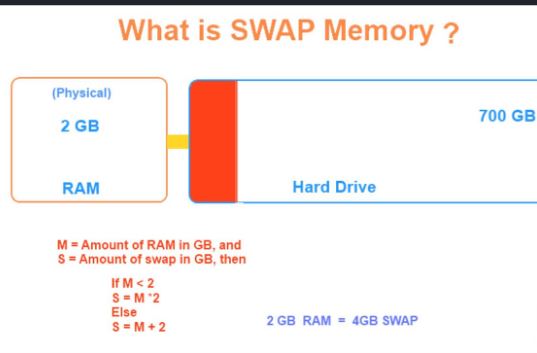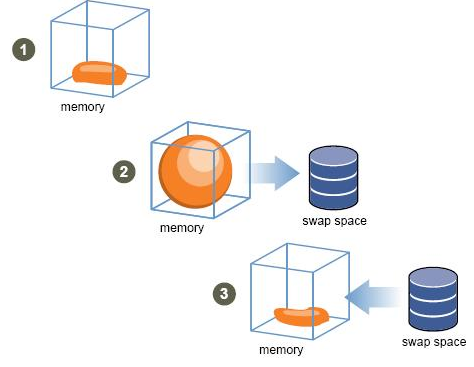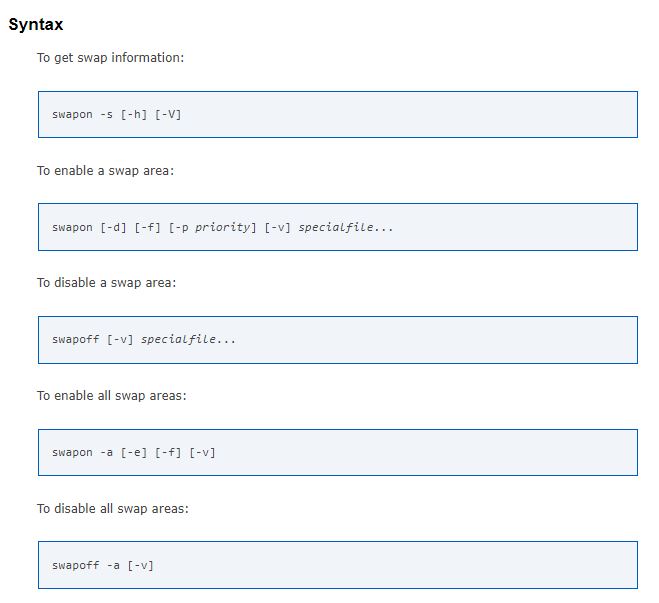
What is Swap in Linux?
Swap is a space on a disk that is used when the amount of physical RAM memory is full. When a Linux system runs out of RAM, inactive pages are moved from the RAM to the swap space.
Swap space can take the form of either a dedicated swap partition or a swap file. In most cases, when running Linux on a virtual machine, a swap partition is not present, so the only option is to create a swap file.
Lets deep dive and understand in more depth.
There are two basic types of memory in a typical computer.
- Random access memory (RAM)
The first type, random access memory (RAM), is used to store data and programs while they are being actively used by the computer. Programs and data cannot be used by the computer unless they are stored in RAM. RAM is volatile memory; that is, the data stored in RAM is lost if the computer is turned off. Hard drives are magnetic media used for long-term storage of data and programs. Magnetic media is nonvolatile; the data stored on a disk remains even when power is removed from the computer. The CPU (central processing unit) cannot directly access the programs and data on the hard drive; it must be copied into RAM first, and that is where the CPU can access its programming instructions and the data to be operated on by those instructions. During the boot process, a computer copies specific operating system programs, such as the kernel and init or systemd, and data from the hard drive into RAM, where it is accessed directly by the computer’s processor, the CPU.

- Swap space
The second type of memory in modern Linux systems is swap space. The primary function of swap space is to substitute disk space for RAM memory when real RAM fills up and more space is needed.


Useful Commands to Monitor Swap Space Usage in Linux
| How to add Swap File? Create a file that will be used for swap: | |
| $ sudo fallocate -l 1G /swapfile | |
| Only the root user should be able to write and read the swap file. To set the correct permissions type: | |
| $ sudo chmod 600 /swapfile | |
| Use the mkswap utility to set up the file as Linux swap area: | |
| $ sudo mkswap /swapfile | |
| To verify that the swap is active, use either the swapon or the free command as shown below: | |
| $ sudo swapon --show | |
| First, deactivate the swap by typing: | |
| $ sudo swapoff -v /swapfile | |
| Turn off the swap partition with the command which turns off all swap space: | |
| $ swapoff -a | |
| Now display the existing partitions on the hard drive. | |
| $ $ fdisk -l | |
| Remove the swap file entry /swapfile swap swap defaults 0 0 from the /etc/fstab file. | |
| Finally, delete the actual swapfile file using the rm command: | |
| $ sudo rm /swapfile | |
| To view all devices marked as swap in the /etc/fstab file you can use the --all option. Though devices that are already working as swap space are skipped. | |
| $ swapon --all | |
| Disable swap | |
| $ sudo swapoff -a | |
| $ sudo sed -i '/ swap / s/^/#/' /etc/fstab | |
| If you want to view a summary of swap space usage by device, use the --summary option as follows. | |
| $ swapon --summary | |
| The free command is used to display the amount of free and used system memory. Using the free command with -h option, which displays output in a human readable format. | |
| $ free -h |
I’m a DevOps/SRE/DevSecOps/Cloud Expert passionate about sharing knowledge and experiences. I am working at Cotocus. I blog tech insights at DevOps School, travel stories at Holiday Landmark, stock market tips at Stocks Mantra, health and fitness guidance at My Medic Plus, product reviews at I reviewed , and SEO strategies at Wizbrand.
Please find my social handles as below;
Rajesh Kumar Personal Website
Rajesh Kumar at YOUTUBE
Rajesh Kumar at INSTAGRAM
Rajesh Kumar at X
Rajesh Kumar at FACEBOOK
Rajesh Kumar at LINKEDIN
Rajesh Kumar at PINTEREST
Rajesh Kumar at QUORA
Rajesh Kumar at WIZBRAND

 Starting: 1st of Every Month
Starting: 1st of Every Month  +91 8409492687
+91 8409492687  Contact@DevOpsSchool.com
Contact@DevOpsSchool.com
 by
by 